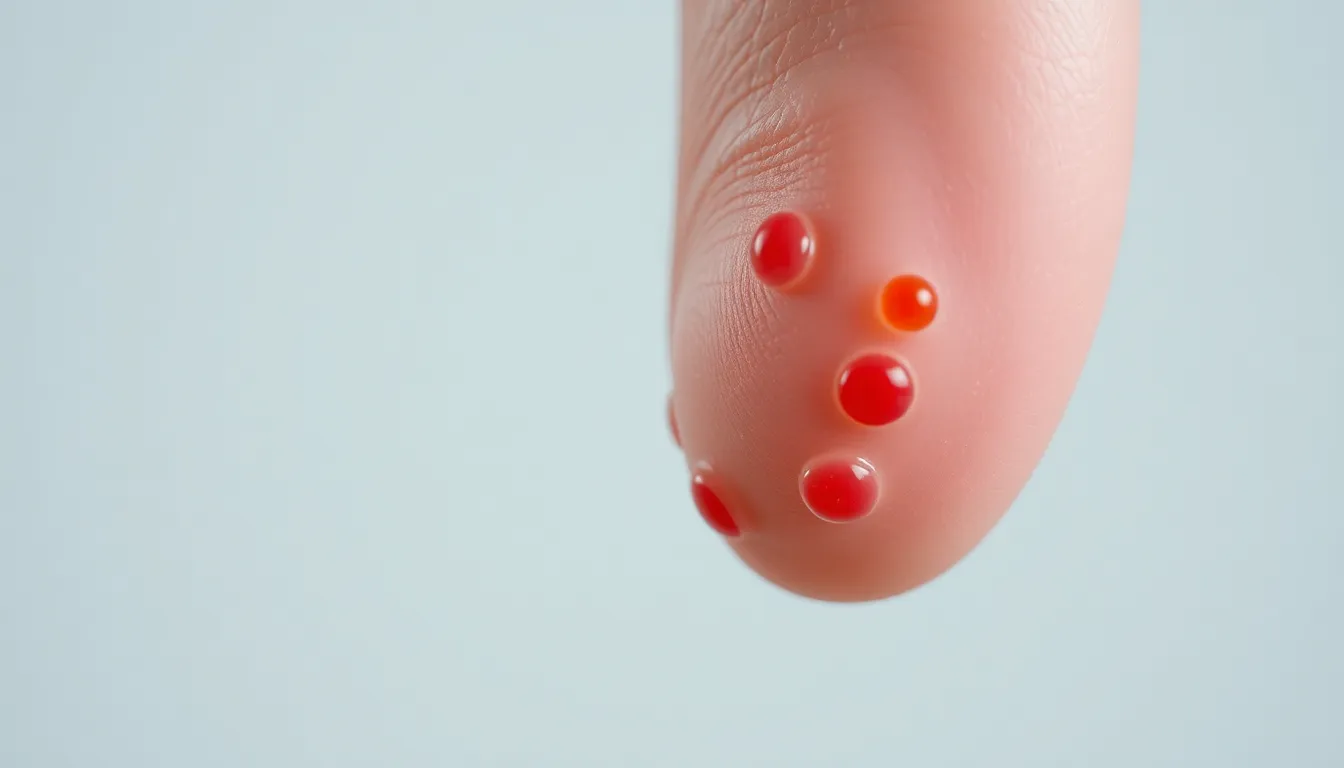Red dots on the penis head can send anyone into a mini panic. Suddenly, that innocent itch or slight irritation feels like the plot twist of a horror movie. But before jumping to conclusions or scheduling an emergency visit to the doctor, it’s essential to take a breath and get informed.
Table of Contents
ToggleUnderstanding Red Dots on Penis Head
Red dots on the penis head can cause concern. Recognizing their causes and implications helps in addressing the issue effectively.
Common Causes
Irritation often leads to red dots on the penis head. Factors like friction from sexual activity or tight clothing contribute significantly. Infections, such as yeast infections or sexually transmitted infections (STIs), may also cause red dots. Allergic reactions to soaps or lubricants sometimes result in similar symptoms. Many individuals experience spots after not practicing proper hygiene.
Less Common Causes
Pearly penile papules appear as small, harmless bumps around the glans. While they present similarly to red dots, they are a normal anatomical variation. Allergic reactions could include more severe symptoms, leading to redness or bumps. Dermatitis presents as an inflammation of the skin, causing redness and irritation. Tumors, though rare, may also manifest as red dots and warrant immediate medical attention.
Symptoms Associated with Red Dots

Red dots on the penis head can manifest alongside various symptoms that indicate the underlying issue’s severity. Recognizing these symptoms aids in determining the appropriate course of action.
Itching or Discomfort
Itching often accompanies red dots, signaling irritation or an allergic reaction. Discomfort may arise during sexual activity or while wearing tight clothing. Skin conditions like dermatitis can cause itchiness, inflaming the skin further. Infections, such as yeast infections, may also provoke itching. Engaging in thorough hygiene can alleviate some discomfort, though persistent symptoms warrant professional evaluation. If there’s a change in skin texture or color alongside itching, seeking medical advice becomes crucial.
Pain or Swelling
Pain can appear in tandem with red dots, indicating possible irritation or infection. Swelling often accompanies painful sensations, suggesting inflammation or fluid accumulation. Sexually transmitted infections (STIs) frequently cause both symptoms, affecting overall genital health. Other conditions like herpes may also lead to noticeable pain and swelling. Observing the duration and intensity of these symptoms provides valuable information for healthcare providers. When swelling or pain is persistent or worsening, it’s essential to consult a medical professional for accurate diagnosis and treatment.
Diagnosis and When to See a Doctor
Diagnosing red dots on the penis head involves a thorough assessment by a healthcare professional. Doctors often evaluate medical history and perform a physical examination to identify the cause. Conditions like infections may require laboratory tests for confirmation, while allergies can usually be diagnosed based on symptoms and exposure history.
All red dots don’t necessarily indicate a serious issue. Irritants such as soaps, lubricants, or tight clothing can lead to minor irritations. In contrast, persistent symptoms such as itching, pain, or swelling warrant medical attention. These symptoms may signal conditions like a sexually transmitted infection or an allergic reaction.
Performing self-examinations can aid early detection of concerning changes. If the red dots spread, become painful, or do not respond to over-the-counter treatments, seeking medical advice becomes crucial. Timely consultation can lead to prompt treatment and relief from discomfort.
Recognizing when to seek medical attention is vital. Serious conditions, though rare, can present as red dots. Immediate medical help is necessary if these dots are accompanied by fever, abnormal discharge, or ulcers. Early diagnosis can prevent complications and ensure effective treatment.
Understanding symptoms and their implications helps prioritize doctor visits. Consulting a healthcare provider encourages accurate diagnosis and personalized treatment plans for proper care.
Treatment Options
Several treatment options exist for managing red dots on the penis head, ranging from home remedies to medical interventions.
Home Remedies
Home remedies may provide relief for minor irritation and discomfort. Soaking in warm water can soothe the area, while applying aloe vera gel offers cooling effects and promotes healing. Over-the-counter hydrocortisone cream reduces inflammation. Avoiding potential irritants, including harsh soaps and tight clothing, helps prevent further irritation. Maintaining proper hygiene with mild soap and warm water supports healthy skin. Keeping the genital area dry prevents moisture-related issues, which can worsen symptoms. If the red dots persist despite these measures, seeking professional advice becomes essential.
Medical Treatments
Medical treatments target underlying infections or allergies causing red dots. A healthcare provider may prescribe antibiotics for bacterial infections, including STIs. Antifungal creams treat fungal infections like yeast. For allergy-related issues, corticosteroids may reduce inflammation. A doctor might suggest topical treatments for persistent symptoms or refer the individual to a dermatologist for specialized care. If complications arise or symptoms worsen, timely medical attention becomes crucial for effective management and recovery. Regular follow-ups ensure the treatment works well and any necessary adjustments can be made.
Noticing red dots on the penis head can be concerning but staying calm and informed is key. While many causes are harmless and related to irritation or allergies, some symptoms may require medical evaluation. Recognizing accompanying signs like itching or pain helps in determining whether to seek professional advice.
Maintaining good hygiene and avoiding irritants can often alleviate minor issues. However, persistent symptoms or changes in condition should prompt a visit to a healthcare provider for proper diagnosis and treatment. Being proactive about health ensures timely intervention and peace of mind.







